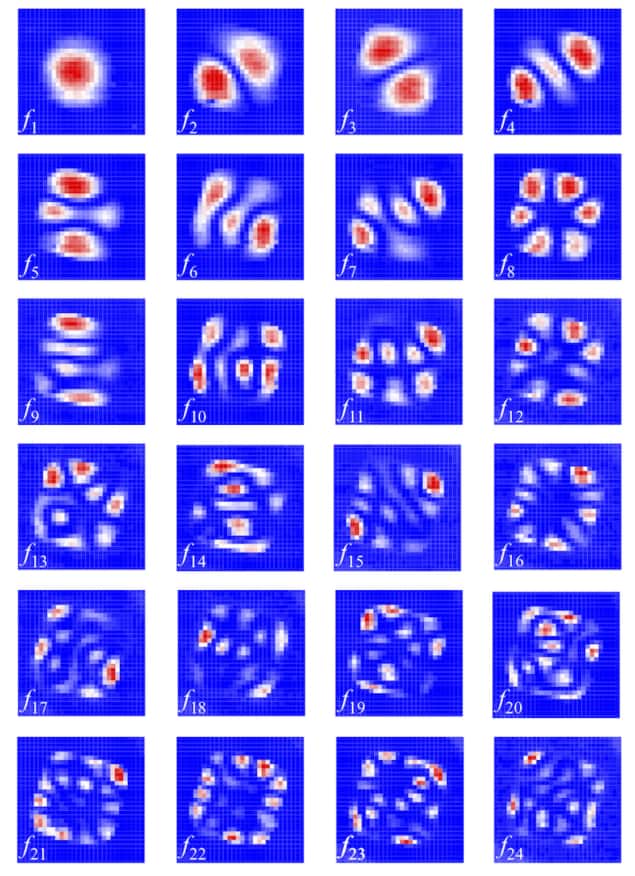Laser interferometry moves closer to shot-noise-limited measurements
13 Mar 2023 Isabelle Dumé
Mapping thermomechanical resonance: thermomechanical modes in a calcium niobate resonator device. (Courtesy: Chinese Phys. Lett. 10.1088/0256-307X/40/3/038102)
Researchers have moved a step closer to achieving quantum-noise-limited measurements using laser interferometry – a technique routinely employed for detecting the motion and displacement of tiny objects such as nanomechanical resonators with ultrasensitive precision. By reducing the contribution of all noises other than shot noise from 92.6% to 62.4%, they achieved a displacement sensitivity of 1.2 fm/Hz1/2. The team says that this is the best value reported to date for any resonator based on two-dimensional (2D) materials using interferometry.
The interference of light waves can be used to measure displacement on the micro- and nano-scales. In the technique, light from a single (laser) light source is split into two or more beams that travel along different optical paths. These paths recombine to produce an interference pattern. Since laser interferometry is so sensitive, it has been used for ultralarge-scale experimental setups such as the kilometre-sized LIGO interferometer, as well as in ultrasmall devices like micro- and nano-mechanical resonators. The latter are particularly interesting since they have been widely used in applications such as sensing, signal processing and computation. They can also be used in fundamental research to probe the boundary between classical physics and quantum mechanics.
As in all micro- and nano-structures, these resonators contain inherent “mechanical noise”, which comes from the Brownian-motion-dictated thermomechanical resonance. “This noise represents an important limit of device motion,” explains study team leader Max Zenghui Wang from the University of Electronic Science and Technology of China, “and it often sets the lower boundary of signal transduction in these mechanical devices.”
Fundamental noise
Typically, thermomechanical noise is on the order of 10–102 fm/Hz1/2. For comparison, the Bohr radius of a hydrogen atom is 5.3 x 104 fm. Resolving this noise from the measurement noise background is therefore an important challenge for researchers, requiring them to very carefully optimize the signal transduction process. Laser interferometry can be used to do this for many micro- and nano-mechanical resonators, including those based on 2D materials and their heterostructures, which represent some of the thinnest man-made vibrating structures.
“In these devices, the moving part interacting with the laser can be as thin as just one individual layer of atoms,” explains Wang. “The thing is that there are still limits to the technique’s sensitivity, with shot noise being a fundamental one.”
Shot noise is a form of quantum noise that arises from the quantized nature of the photon, which reaches the photodetector with a finite level of uncertainty. While other sources of noise in the measurement can be minimized through optimized design and engineering, shot noise is a fundamental process that depends on the laser power and can only be mitigated using highly complicated designs.
“In a measurement in which all other noise sources have been minimized and shot noise dominates, it is said to be shot-noise limited or quantum-noise limited,” says Wang.
Towards the shot-noise limit
In their work, which is detailed in Chinese Physics Letters, the researchers showed that they could improve the measurement sensitivity towards the shot-noise limit in a nanomechanical resonator based on 2D calcium niobate (CaNb2O6). Their approach involved characterizing the different noise processes present in the system one by one.
First, they turned on the measurement instrument (a spectrum analyser) with no input connected and recorded its noise spectrum. Next, they added a photodetector, but with no incident light impinging on it, which allowed them to characterize the electrical noise of the detector. Then, they allowed laser light to hit the detector so that they could characterize the laser noise. They could subsequently calculate the shot noise by measuring the laser power.
“Finally, we let the laser reflect from the device before it reached the photodetector,” Wang tells Physics World. “This allows the device’s thermal noise to show up on top of all the other noise processes. Such step-by-step characterization is key to the noise analysis and enables us to tackle each noise process individually.”
“The 1.2 fm/Hz1/2 sensitivity achieved is by far the best value to date among all 2D resonators measured using interferometry,” he adds. “And while we have not exactly reached the shot-noise-limit yet, in principle there is no physical law preventing us from reaching it using our new approach.”READ MORE

In future work, the researchers plan to explore the transition between quantum mechanical motion and thermal motion in nanomechanical devices using the enhanced sensitivity offered by the new technique.
“As a device is cooled down, the magnitude of its thermal motion also decreases and becomes harder to detect,” says Wang. “At some point, however, thermal fluctuation gives way to quantum fluctuation, which is dictated by the so-called zero-point motion. Such a phenomenon can be quantitively described using the quantum fluctuation dissipation theorem and it turns out that for 2D nanomechanical resonators, such a transition temperature is within reach of the cryogenic temperatures available to us today.”
“With the new ultrasensitive technique, the possibly of measuring the noise motion at cryogenic temperature is now closer to reality than ever before,” Wang adds. “This will allow researchers to explore the boundary between the quantum and classical worlds using these resonating nanostructures.”

Isabelle Dumé is a contributing editor to Physics World
FROM PHYSICSWORLD.COM 22/3/2023

Δεν υπάρχουν σχόλια:
Δημοσίευση σχολίου